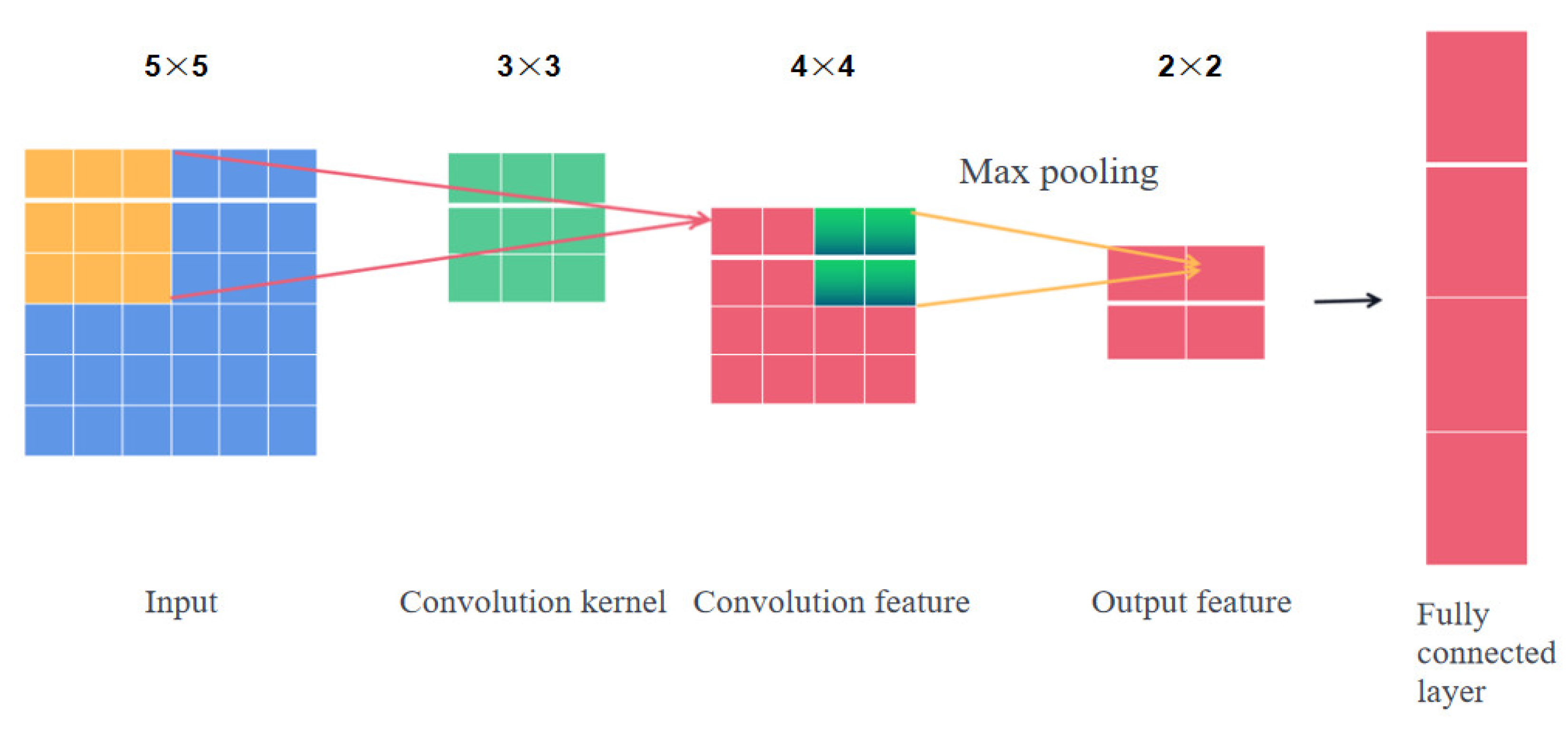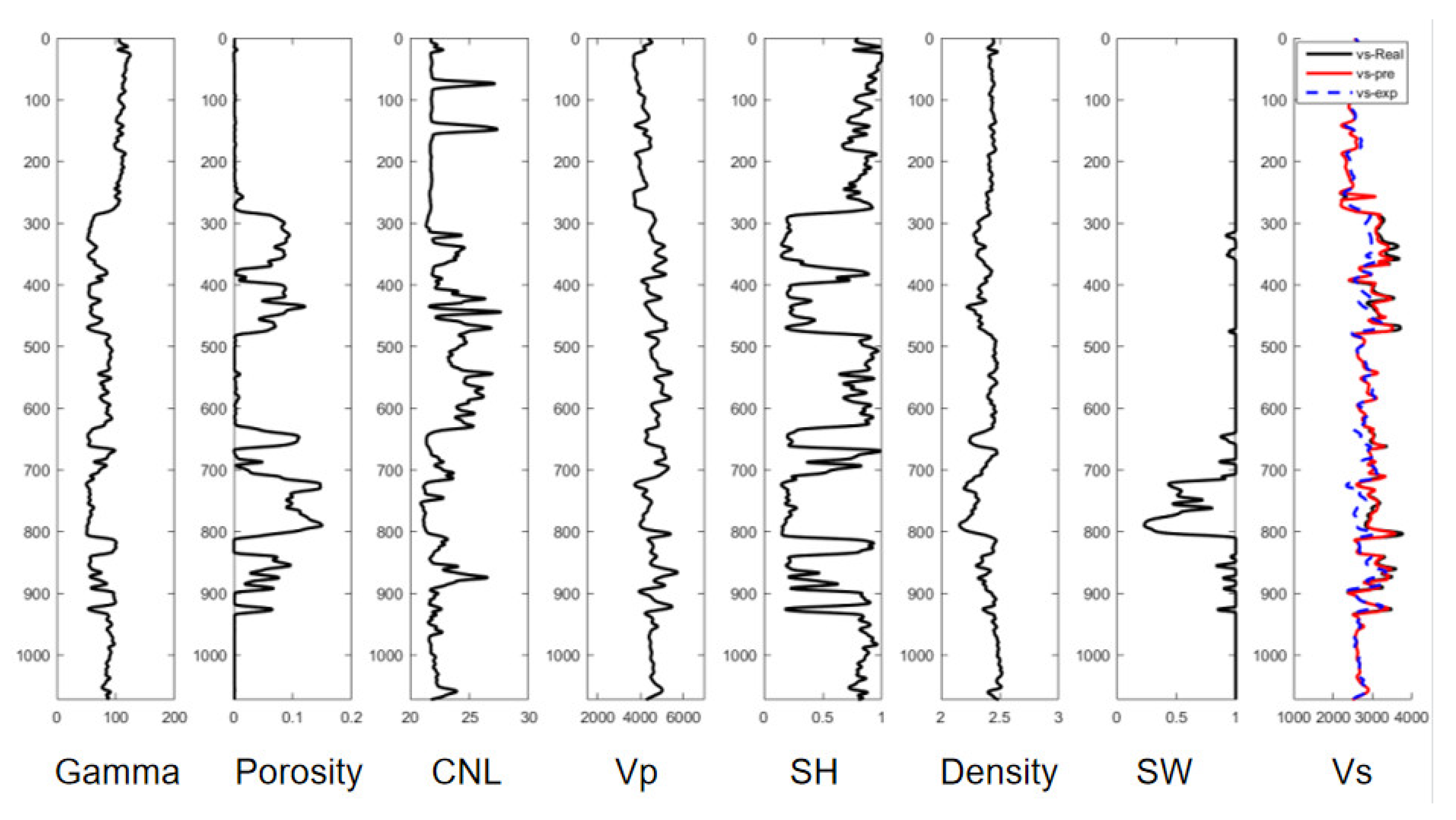Predicting Shear Wave Velocity Using a Convolutional Neural Network and Dual-Constraint Calculation for Anisotropic Parameters Incorporating Compressional and Shear Wave Velocities
Abstract
:1. Introduction
2. Principles and Workflow for Predicting Anisotropic Parameters
2.1. Convolutional Neural Network
2.2. The Principle of Constructing Anisotropic Rock Physics Models Involves
2.3. Workflow for Predicting Anisotropic Parameters Based on Dual Constraints of Compressional and Shear Wave Velocities
- (1)
- Estimate the elastic modulus of the mixed minerals after mixing using the Voigt–Reuss–Hill averaging formula.
- (2)
- Calculate the volume modulus and shear modulus of the dry rock skeleton using the differential effective medium theory and the K–T model.
- (3)
- Incorporate the fracture system into an isotropic background using the Hudson and Schoenberg theories.
- (4)
- Mix the pore fluids using the Wood formula and calculate the bulk modulus of the mixed fluid.
- (5)
- Perform anisotropic fluid substitution using the Brown and Korringna formulas.
- (6)
- Preprocess the well-logging data, including data standardization, normalization, and partitioning into training and testing sets.
- (7)
- Train the CNN using a training set, calculate the errors, and check for convergence. If the errors diverge, retrain the CNN. If the errors converge, apply the trained CNN to the testing set to predict the transverse wave velocity.
- (8)
- Apply dual constraints by comparing the predicted anisotropic parameters based on the transverse wave velocity obtained from the CNN with the compressional wave velocity obtained from the well-logging data.
3. Numerical Experiments
3.1. Factor Analysis
3.2. Dual-Constraint Numerical Experiments
4. Practical Applications
5. Conclusions
- (1)
- Using CNNs, the proposed method outperformed conventional techniques in predicting shear wave velocity, yielding higher prediction accuracy.
- (2)
- The anisotropic rock physics model developed for tight sandstone revealed that both compressional and shear wave velocities increased with the quartz and clay porosity ratios, while they decreased as the fracture density increased. The influence of the clay mineral porosity ratio on the model was relatively minor.
- (3)
- The results obtained from both the model and actual data collected from the Junggar Basin validated the prediction that anisotropic parameters based on the dual constraints of compressional and shear wave velocities would achieve superior accuracy compared to relying solely on the single constraint of compressional wave velocity.
Author Contributions
Funding
Data Availability Statement
Acknowledgments
Conflicts of Interest
References
- Wang, H.-F.; Ma, J.-F.; Li, L.; Wang, D.-X.; Wang, Y.-G. Research on predicting S-wave velocity in tight reservoir: Sulige gas field for example. Prog. Geophys. 2019, 34, 1521–1529. (In Chinese) [Google Scholar] [CrossRef]
- Chen, Y.; Sun, Z.T.; Xu, K. Pre-stack multi-parameter seismic inversion in shale-gas reservoirs. Geophys. Prospect. Pet. 2022, 61, 1016–1027. [Google Scholar]
- Liu, Q.W.; Hu, W.; Li, Q. Application of Pre-stack optimized AVO inversion based on Xu-White model in the deep sea turbidite reservoir. Miner. Explor. 2023, 14, 214–222. [Google Scholar]
- Castagna, J.P.; Batzle, M.L.; Eastwood, R.I. Relationship between compressional wave and shear wave velocities in clastic rocks. Geophysics 1985, 50, 571–581. [Google Scholar] [CrossRef]
- Han, D.H.; Nur, A.; Morgan, D. Effects of porosity and clay content on wave velocities. Geophysics 1986, 51, 2093–2107. [Google Scholar] [CrossRef]
- Russell, B.H.; Hedlin, K. Fluid-property discrimination with AVO: A Biot-Gassman perspective. Geophysics 2003, 68, 29–39. [Google Scholar] [CrossRef] [Green Version]
- Hossain, Z.; Mukerji, T.; Fabricius, I.L. Vp-Vs relationship and amplitude variation with offset modelling of glauconitic greensand. Geophys. Prospect. 2015, 60, 117–137. [Google Scholar] [CrossRef]
- Mabrouk, W.M.; Pennington, W.D. Compressional and shear wave velocity in terms of petrophysical parameters in clean formations. J. Pet. Sci. Eng. 2009, 65, 62–66. [Google Scholar] [CrossRef]
- Ojha, M.; Sain, K. Velocity-porosity and velocity-density relationship for shallow sediments in the Kerala-Konkan basin of western Indian margin. J. Geol. Soc. India 2014, 84, 187–191. [Google Scholar] [CrossRef]
- Rezaee, M.R.; Ilkhchi, A.K.; Barabadi, A. Prediction of shear wavevelocity from petrophysical data utilizing intelligent systems: An example from a sandstone reservoir of Canarvon Basin, Australia. J. Pet. Sci. Eng. 2007, 55, 201–212. [Google Scholar] [CrossRef] [Green Version]
- Asoodeh, M.; Bagheripour, P. Prediction of compressional, shear and stoneley wave velocities from conventional well log data using a committee machine with intelligent systems. Rock Mech. Rock Eng. 2012, 45, 45–63. [Google Scholar] [CrossRef]
- Akhundi, H.; Ghafoori, M.; Lashkaripour, G.R. Prediction of shear wave velocity using artificial neural network technique, multiple regression and petrophysical data: A case study in Asmari reservoir (SWIran). Open J. Geol. 2014, 4, 303–313. [Google Scholar] [CrossRef] [Green Version]
- Wang, P.; Peng, S. On a new method of estimating shear wave velocity from conventional well logs. J. Pet. Sci. Eng. 2019, 180, 105–123. [Google Scholar] [CrossRef]
- Xiong, W.; Ji, X.; Ma, Y. Seismic fault detection with convolutional neural network. Geophysics 2018, 83, O97–O103. [Google Scholar] [CrossRef]
- Das, V.; Pollack, A.; Wollner, U.; Mukerji, T. Convolutional neural network for seismic impedance inversion. Geophysics 2019, 84, R869–R880. [Google Scholar] [CrossRef]
- Das, V.; Mukerji, T. Petrophysical properties prediction from prestack seismic data using convolutional neural networks. Geophysics 2020, 85, N41–N55. [Google Scholar] [CrossRef]
- Wang, K.X.; Huang, Q.H.; Wu, S.H. Application of long short-term memory neural network in geoelectric field data processing. Chin. J. Geophys. 2020, 63, 3015–3024. [Google Scholar]
- Pham, N.; Wu, X.M.; Naeini, E.Z. Missing well log prediction using convolutional long short-term memory network. Geophysics 2020, 85, WA159–WA171. [Google Scholar] [CrossRef]
- Graves, A.; Mohamed, A.R.; Hinton, G. Speech recognition with deep recurrent neural networks. In Proceedings of the IEEE International Conference on Acoustics, Speech and Signal Processing (ICASSP), Vancouver, BC, Canada, 26–31 May 2013; pp. 6645–6649. [Google Scholar]
- Sun, Y.H.; Liu, Y. Prediction of S-wave velocity based on GRU neural network. Oil Geophys. Prospect. 2020, 55, 484–492. [Google Scholar]
- Nur, A. Critical porosity and the seismis velocities in rocks. EOS Trans. Am. Geophys. Union 1992, 73, 43–66. [Google Scholar]
- Xu, S.; White, R.E. A new velocity model for clay-sand mixture. Geophys. Prospect. 1995, 43, 91–118. [Google Scholar] [CrossRef]
- Bai, J.Y.; Yue, C.Q.; Liang, Y.Q.; Song, Z.X.; Ling, S.; Zhang, Y.; Wu, W. Variable aspect ratio method in the Xu-White model for shear-wave velocity estimation. J. Geophys. Eng. 2013, 10, 035008-1–035008-6. [Google Scholar] [CrossRef]
- Liu, Z.; Sun, S.Z. The differential Kuster–Toksoz rock physics model for predicting S-wave velocity. J. Geophys. Eng. 2015, 12, 839–848. [Google Scholar] [CrossRef]
- Yang, Y.-H.; Gao, G.; Wei, H.-M.; Zhang, J.-Z.; Gui, Z.-X. Application of pre-stack simultaneous inversion in reservoir and fluid identification of the calcareous development zone. Prog. Geophys. 2017, 32, 332–338. (In Chinese) [Google Scholar]
- Xu, S.Y.; Payne, M.A. Modeling elastic properties in carbonate rocks. Lead. Edge 2009, 28, 66–74. [Google Scholar] [CrossRef]
- Zhang, G.Z.; Li, C.C.; Yin, X.Y.; Zhang, J.Q. Corrected Xu-White model for carbonate S-wave velocity estimation. Oil Geophys. Prospect. 2012, 32, 717–722. (In Chinese) [Google Scholar]
- Huang, X.R.; Huang, J.P.; Li, Z.C. Anisotropic seismic rock physics model of tight oil sandstone based on double-porosity theory. Acta Pet. Sin. 2015, 36, 1248–1259. [Google Scholar]
- Yuan, H.Z. Study of Anisotropic Rock Physics Model and Application. Ph.D. Thesis, China University of Petroleum, Beijing, China, 2007. [Google Scholar]
- Guo, Z.-Q.; Liu, C.; Liu, X.-W.; Dong, N.; Liu, Y.-W. Research on anisotropy of shale oil reservoir based on rock physics model. Appl. Geophys. 2016, 13, 382–392. [Google Scholar] [CrossRef]
- Chen, S.; Zhong, Q.; Li, Z.; Zhang, M.; Zhao, X.; Li, X. Petrophysical modeling of horizontal bedding-parallel fractures and its seismic response characteristics. Oil Gas Geol. 2020, 41, 1273–1281, 1287. [Google Scholar] [CrossRef]
- Hudson, J.A. Overall properties of a cracked solid. Math. Proc. Camb. Philos. Soc. 1980, 88, 371–384. [Google Scholar] [CrossRef]
- Hudson, J.A. Wave speeds and attenuation of elastic waves in material containing cracks. Geophys. J. R. Astron. Soc. 1981, 64, 133–150. [Google Scholar] [CrossRef]
- Kumar, M.; Han, D. Pore shape effect on elastic properties of carbonate rocks. SEG Tech. Program Expand. Abstraetsl 2005, 24, 1477–1480. [Google Scholar]
- Zhang, G.-Z.; Chen, H.-Z.; Wang, Q.; Yin, X.-Y. Estimation of S-wave velocity and anisotropic parameters using fractured carbonate rock physics model. Chin. J. Geophys. 2013, 56, 1707–1715. (In Chinese) [Google Scholar] [CrossRef]
- Chen, H.-Z.; Yin, X.-Y.; Gao, J.-H.; Liu, B.-Y.; Zhang, G.-Z. Seismic inversion for underground fractures detection based on effective anisotropy and fluid substitution. Sci. China Earth Sci. 2015, 58, 805–814. [Google Scholar] [CrossRef]
- Thomsen, L. Weak elastic anisotropy. Geophysics 1986, 51, 1954–1966. [Google Scholar] [CrossRef]







| Vp | Vs | e | |||||||
|---|---|---|---|---|---|---|---|---|---|
| Actual Data | 4015 | 22680 | 0.1238 | 2.1624 | 0.01 | 0.0471 | 0.0232 | 0.15 | 0.03 |
| Dual Constraint | 4121 | 2761 | 0.1238 | 2.1624 | 0.009 | 0.0431 | 0.0209 | 0.13 | 0.05 |
| Single Constraint | 4220 | 2815 | 0.1238 | 2.1624 | 0.003 | 0.0145 | 0.007 | 0.1 | 0.08 |
Disclaimer/Publisher’s Note: The statements, opinions and data contained in all publications are solely those of the individual author(s) and contributor(s) and not of MDPI and/or the editor(s). MDPI and/or the editor(s) disclaim responsibility for any injury to people or property resulting from any ideas, methods, instructions or products referred to in the content. |
© 2023 by the authors. Licensee MDPI, Basel, Switzerland. This article is an open access article distributed under the terms and conditions of the Creative Commons Attribution (CC BY) license (https://creativecommons.org/licenses/by/4.0/).
Share and Cite
Liu, J.; Gui, Z.; Gao, G.; Li, Y.; Wei, Q.; Liu, Y. Predicting Shear Wave Velocity Using a Convolutional Neural Network and Dual-Constraint Calculation for Anisotropic Parameters Incorporating Compressional and Shear Wave Velocities. Processes 2023, 11, 2356. https://doi.org/10.3390/pr11082356
Liu J, Gui Z, Gao G, Li Y, Wei Q, Liu Y. Predicting Shear Wave Velocity Using a Convolutional Neural Network and Dual-Constraint Calculation for Anisotropic Parameters Incorporating Compressional and Shear Wave Velocities. Processes. 2023; 11(8):2356. https://doi.org/10.3390/pr11082356
Chicago/Turabian StyleLiu, Jiaqi, Zhixian Gui, Gang Gao, Yonggen Li, Qiang Wei, and Yizhuo Liu. 2023. "Predicting Shear Wave Velocity Using a Convolutional Neural Network and Dual-Constraint Calculation for Anisotropic Parameters Incorporating Compressional and Shear Wave Velocities" Processes 11, no. 8: 2356. https://doi.org/10.3390/pr11082356





